The actual iRobot Roomba models are 614, 690, 890, 960 and 980. In this list the models are placed from the most basic and affordable 614 to the most advanced and expensive 980.
| Roomba | 614 | 690 | 890 | 960 | 980 |
|---|---|---|---|---|---|
 |
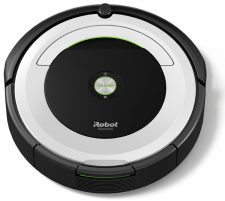 |
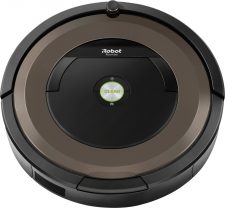 |
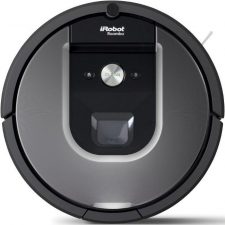 |
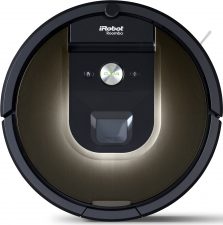 |
|
| Price | $224.00 | $379.99 | $383.89 | $449.00 | $912.41 |
| Cleaning system | AeroVac | AeroForce | AeroForce with Gen 3 Motor | ||
| Navigation | iAdapt random | iAdapt 2.0 mapped | |||
| Filter | Ordinary | High-Efficiency | |||
| Wi-Fi | No | Yes | |||
| Li-ion battery | 14.4V 1800mAh 25.9Wh | 14.8V 2130mAh 31.5Wh | 14.4V 3300mAh 47.5Wh | ||
| Runtime on hard floor | 60 minutes | 73 minutes | 110 minutes | ||
| Virtual walls in package | No | 1 | 2 | ||
| Dirt Detect | Series 1 | Series 2 | |||
| Full bin indicator | No | Yes | |||
| Full bin behavior | n/a | No | Yes | ||
| Extra side brush | No | 1 | |||
| Cliff sensors | 4 | 6 | |||
Common features
Design
All the Roombas are round, have an equal height (3.6 inches) and nearly the same diameter, around 13.8 inches. On the top, they all have three buttons, clean, spot and home/dock.
Every Roomba is driven by two big wheels and has one small non-drive caster wheel. The maximum height of a threshold that all Roomba models can transition over is 5/8 of an inch.
3-stage cleaning system
All the Roombas employ the same 3-stage cleaning scheme:
- The side brush sweeps dust from the floor, along the walls and partially from corners into the path of the dual roller brushes.
- Dual roller brushes agitate the dirt on the floor and in carpets and pick up the dust swept by the side brush, taking it to the input port of the vacuuming bin.
- The fan sucks the dust into the bin.
All the Roombas have the same side brush on their right and dual roller brushes, which rotate in opposite directions to transfer debris from the floor to the inside of the vacuum.
Roller brushes are housed in the adjustable cleaning head, which keeps them at the optimal distance from the surface for better cleaning on all types of flooring.
Anti-tangle system
All the Roombas have the anti-tangle system, which activates when the robot occasionally gets wrapped up in a cord, a sock, rug fringe or other item from the floor that tangles and blocks the brushes. The robot tries to free itself by reversing the roller brushes.
Input power
The input power in “normal” mode on hard floors is nearly the same for all models, about 26 watts. However, Roomba 980 has a power boost, which increases input power significantly when turned on.
Return to home base
All the Roombas return to home base when finished cleaning or if the battery is low, and the home base is the same for all the models. Roomba 960 and 980 have also a charge and resume feature.
Virtual wall
All the Roombas are compatible with the same virtual wall barriers. Roomba 614 has no walls included in the package, 690, 890 and 960 have one wall included and 980 comes with two walls.
Cliff sensors
All the Roombas are equipped with cliff sensors and won’t fall off the stairs. Roomba 614, 690 and 890 have four cliff sensors, while 960 and 980 have six. All the models may not run on black surfaces. The optical cliff sensors recognize black color as a drop and will not let the robot to go over it.
Dirt detect
All the models have a dirt detect system to recognize and thoroughly clean the dirtiest areas.
Dirt Detect Series 1
Roomba 614 and 690 have dirt detect series 1, which uses acoustic sensors to detect small particles, and then makes a spiral movement over the dirty spot.
Dirt Detect Series 2 with Persistent Pass
Roomba 890, 960 and 980 have dirt detect series 2 with persistent pass, which uses optical and acoustic sensors to find dirt and debris and perform a back-and-forth movement over the dirty area.
Spot cleaning mode
All the Roombas have a spot cleaning mode. If placed in the center of a particularly dirty area, the robot will move in a spiral motion first outwards, then inwards back to its initial position, cleaning a round spot about 3 feet in diameter.
Noise level
All the Roombas are noisy. Noise levels produced by all the models are nearly the same except for Roomba 980 in “boost” mode, which is much louder. In addition, they all beep and talk loudly with a female voice and this cannot be disabled.
Dustbin emptying and other maintenance
In all models, the dustbin should be emptied after every cleaning cycle. If your pets shed a lot or some time has passed since the last cleaning, it even might be necessary to empty the dustbin in the middle of the cleaning cycle.
The filter, side brush, dual roller brushes, front caster wheel, charging contacts, and sensors should be periodically cleaned. In addition, the filter and side brush will need replacement after some time.
In Roomba 890, 960 and 980 detangling debris extractors is an easy task since they have a much lower profile than traditional roller brushes with bristles and tangled hair is easily dispensed with.
Package
All the models come with one extra filter in the package.
Roomba 960 and 980 also come with one extra side brush.
Specific features
Wi-Fi vs buttons on the robot only
Roomba 614 can be controlled solely by three buttons on top of the robot, which allow you to start/pause/stop cleaning, send the robot home, and run in spot mode.
Roomba 690, 890, 960 and 980 have a 2.4Ghz Wi-Fi connection. Aside from the buttons on the robot, they can be controlled using the same smartphone application for Android or iOS and are compatible with voice devices Amazon Alexa and Google Assistant, which allow you to control them by voice commands. The app allows scheduling the robot up to seven times a week, seeing its status, viewing the cleaning log and room map for models 960 and 980.
AeroVac vs AeroForce
AeroVac
Roomba 614 and 690 have the AeroVac cleaning system, which includes an AeroVac vacuuming bin and dual multi-surface brushes.
The AeroVac bin capacity is about 0.48 liters, and it has a vacuum motor with fan inside and an ordinary filter.
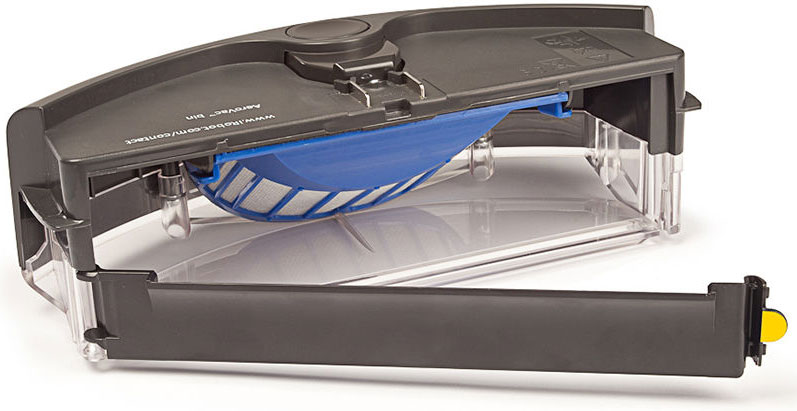
Dual multi-surface brushes consist of one smaller brush with plastic blades and one bigger brush with bristles:
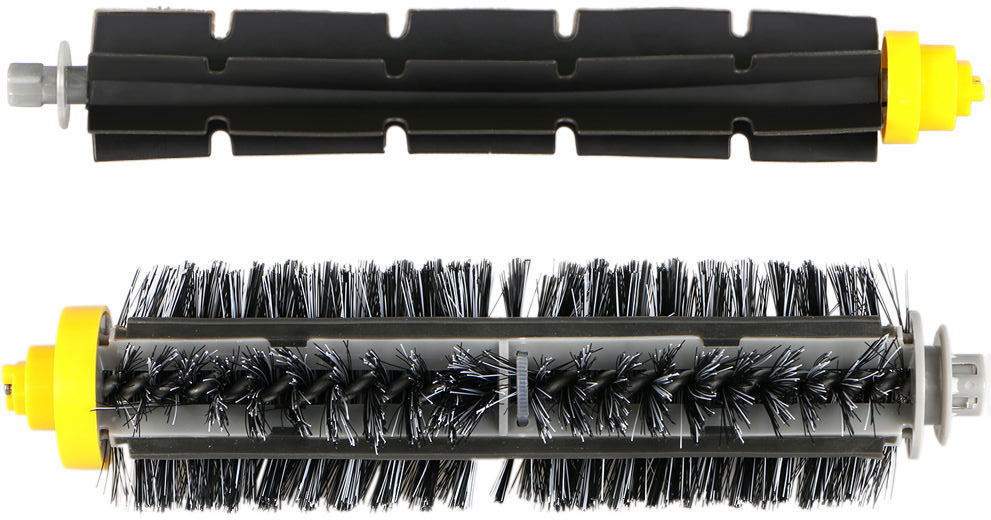
The intake window of the vacuuming bin is right behind the bigger brush so the dust comes directly into the bin:
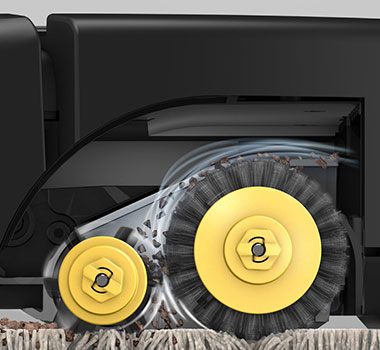
AeroForce
Roomba 890 and 960 have the AeroForce cleaning system, which includes an AeroForce vacuuming bin and debris extractors instead of multi-surface brushes.
Debris extractors are made of rubber-like material and have low-profile solid and dashed blades instead of traditional bristles.

This makes detangling very easy since tangled hair just pops out.
AeroForce bin has an improved gen 2 vacuuming motor and fan, higher capacity of about 0.6 liters and a high-efficiency filter inside.
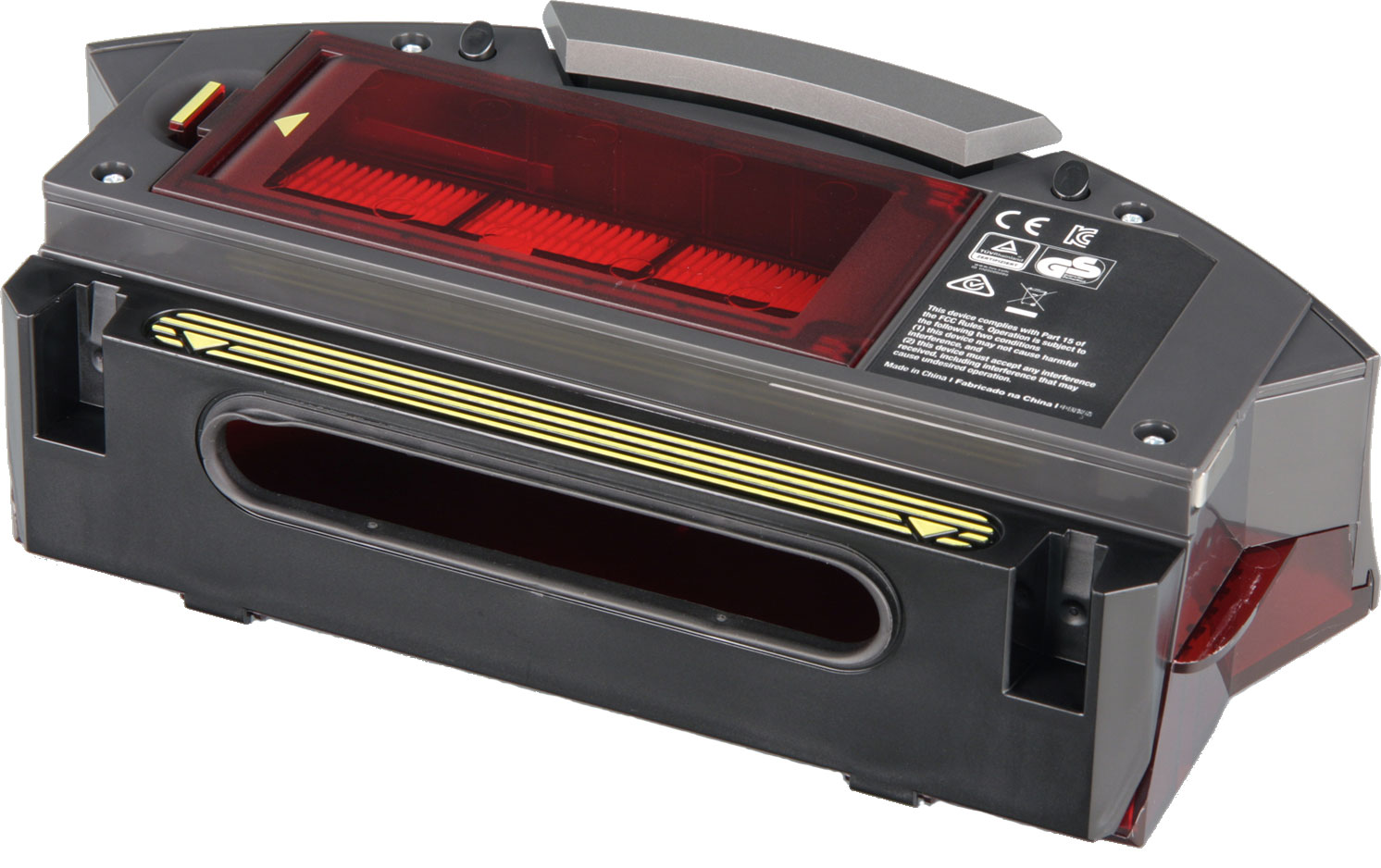
The intake port was redesigned; the whole passage from the bin to the floor was sealed to decrease suction loss and made narrower to increase suction.
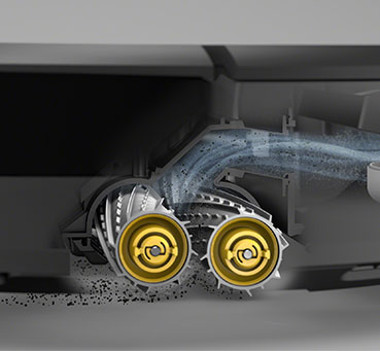
As a result, the AeroForce system has much more suction power on the floor and can suck the dust directly from the floor, which improves the overall cleaning effectiveness. The distance between the roller brushes and bin, however, increased and now dirt is transferred from the roller brushes to the bin solely by suction.
AeroForce with Gen 3 Motor
Roomba 980 got an updated AeroForce with a gen 3 motor. The main improvement is a new, much more powerful motor. The inner construction of the bin was slightly modified to house the new motor. In addition, the bin latch is sturdier than the original AeroForce design and doesn’t loosen after multiple times of transferring it out and back into the robot.
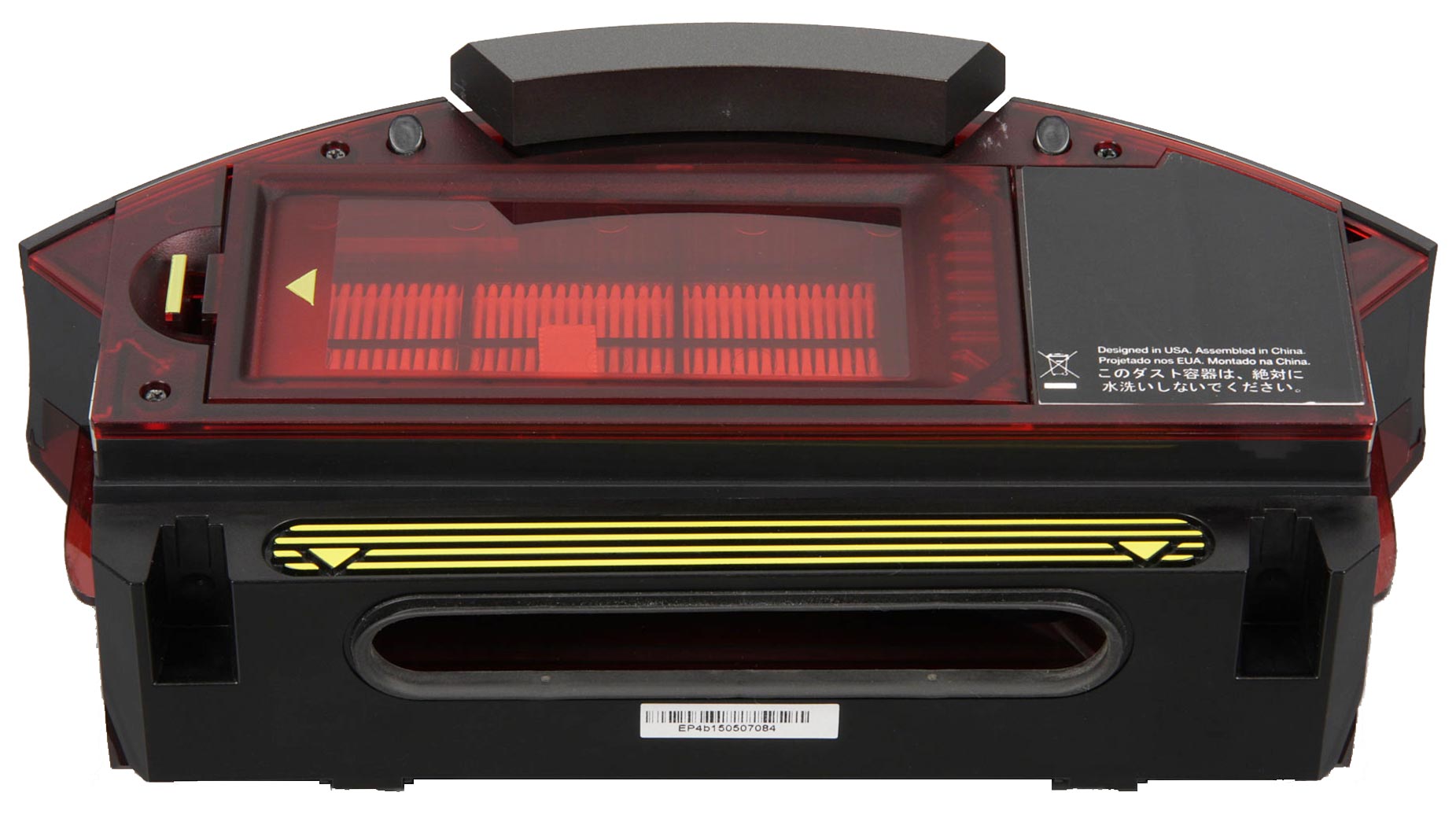
The increase of the motor and suction power is called carpet boost because by default the vacuum runs at lower power on hard floors and automatically boosts to the maximum power at carpets for deeper cleaning. This behavior can be changed to performance mode in which the boost is always on, or to eco-mode in which the vacuum is always run at lower power, which is identical to the original AeroForce.
Boost mode makes a big difference while cleaning high-pile carpets. However, on low carpets and hard floors the benefits are not significant, since AeroForce in “normal” mode already cleans them decently.
Noise level in boost mode is significantly higher than in normal mode.
Navigation
iAdapt random
The Roomba 614, 690 and 890 have advanced random navigation iAdapt. In clean mode, they use different patterns to effectively cover the room:
- Bouncing – the robot goes straight until it meets an obstacle and then randomly changes direction.
- Wall following – if the robot spots a wall on their right, the robot will follow it for some time and sweep along it with the side brush.
- Dirt detect – if the robot detects a particularly dirty spot, it will either make a circle over it or go back and forth depending on the dirt detect series.
- Spiral – if the robot starts from the middle of the room, rather than from the home base, it will start going in a spiral pattern until it meets an obstacle.
The robot doesn’t map the room and therefore doesn’t know where it has already cleaned and where it has yet to clean. Therefore, it can clean certain areas multiple times and at the same time completely miss others.
These robots navigate best in a single room or in an open-plan apartment. They can be run in a multiple-room apartment, but it most likely will clean rooms unequally and will have difficulties in finding its way back to the home base if the cleaning cycle ends in a different room from where the home base is.
The maximum time of a cleaning cycle is set to 60 minutes, which is the estimated runtime on a full battery charge. There is also the room size estimator, which evaluates the room size based on the distances between obstacles the robot has detected. Depending on the estimated room size, the actual cleaning time can be reduced.
These models can effectively clean approximately 1000 square feet in one 60-minute cleaning cycle. To effectively clean bigger or multi-room apartments it’s better to split them into several zones and clean them separately.
iAdapt 2.0 with visual simultaneous localization and mapping (vSLAM)
The Roomba 960 and 980 have iAdapt 2.0 navigation, which maps the room with the visual simultaneous localization and mapping (vSLAM) algorithm using a camera pointed at approximately 45 degrees over the horizon. These robots also have a floor sensor similar to ones used in a computer mouse to track its movement.
Entire level cleaning
These robots can clean a multiple-room apartment up to 2000 square feet. They cover all the areas equally and don’t miss any spots.
The whole apartment is divided into regions and they are cleaned subsequently in neat straight lines perpendicular to the home base back plate. These regions are not always congruent with actual rooms. A single room can be divided into several regions and one region can be split between different rooms. In such a case, the robot will clean the section of a region in one room, then go to another room to clean the other section of the region. Then it can return to the first room and continue cleaning the next region.
The room map created by the robot can be seen in the smartphone app.
Like other models, these robots have dirt detect (series 2) and will go back-and-forth over the areas where a lot of dirt is detected.
Edge cleaning and multiple passes
By default after covering the whole area, the robot will do edge cleaning and go along all the walls before returning to the home base. In addition, you can set it to make two cleaning passes. The robot will clean the whole area twice. The second pass will be parallel to the home base back plate.
Charge and resume
If the battery runs low in the middle of the cleaning, the robot will go to the home base for charging and then resume cleaning from the point where it was before.
Limitations
Since these robots use cameras to map the room, they need visible light to work. Therefore, they cannot be run in the dark. In addition, they continuously track their position in the room and if you manually pick the robot up and move it to another location, it will be lost.
Full bin indicator
Roomba 890, 960 and 980 have a full bin indicator. In Roomba 960 and 980 full bin behavior can be changed in cleaning preferences. You can set the robot to continue cleaning with the full bin or to stop and ask for human help.
Battery and runtime
All the models have Li-ion batteries of different capacities. All the batteries have the same dimensions and are compatible with all the Roomba models.
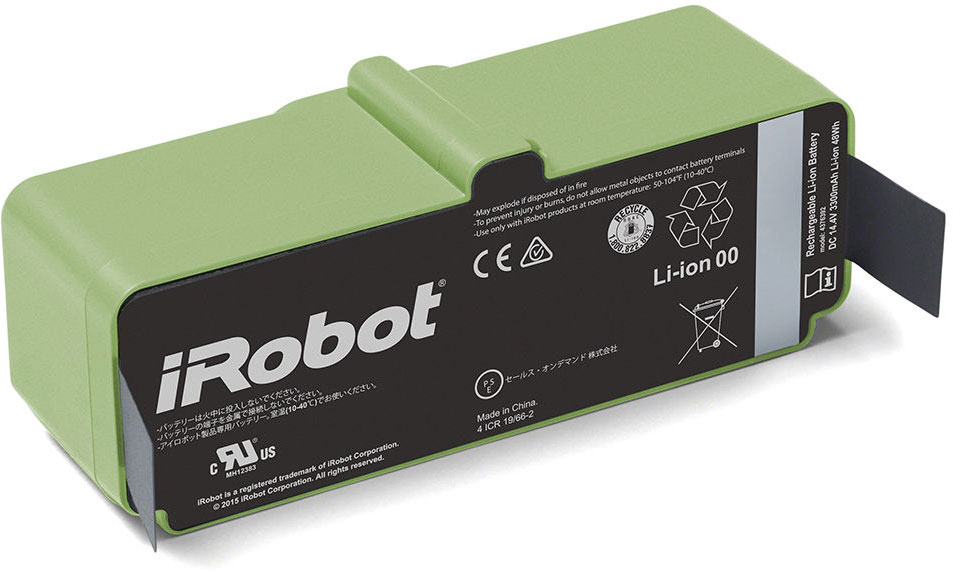
Roomba 614, 690 and 890 have 14.4V 1800mAh 25.9Wh battery, which provides them 60 minutes runtime, matching the maximum cleaning cycle time.
Roomba 960 has 14.8V 2130mAh 31.5Wh which gives it 73 minutes runtime.
Roomba 980 has 14.4V 3300mAh 47.5Wh and can run for 110 minutes on a full charge in normal mode on hard floors.
Roomba 614 vs 690 vs 890 vs 960 vs 980 comparison
Roomba 614
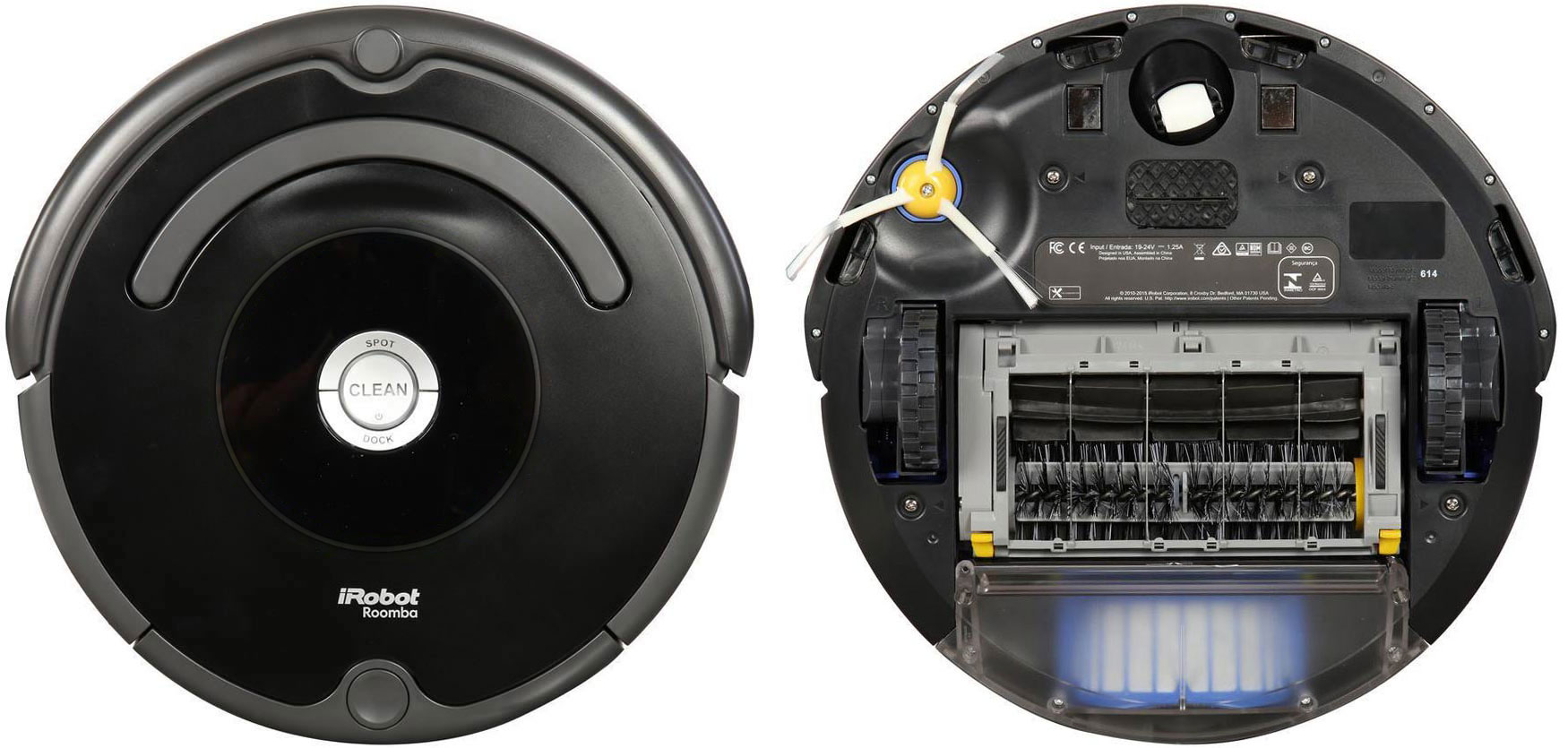
Roomba 614 is the most basic model. It has a side brush, an AeroVac vacuuming bin with an ordinary filter, dual multi-surface brushes in the adjustable cleaning head, iAdapt random navigation, dirt detect series 1, four cliff sensors, Li-ion 14.4V 1800mAh 25.9Wh battery, which allows it to run for 60 minutes on a full charge. It’s compatible with virtual walls, but doesn’t include them in a package. Roomba 614 can be controlled solely with the buttons on the robot. It comes with one extra filter.
Roomba 690

Roomba 690 is identical to 614 in terms of cleaning. Aside from all the features of 614 it has a Wi-Fi connection and can be controlled and scheduled via the smartphone app, and also comes with one virtual wall in the package.
Roomba 890
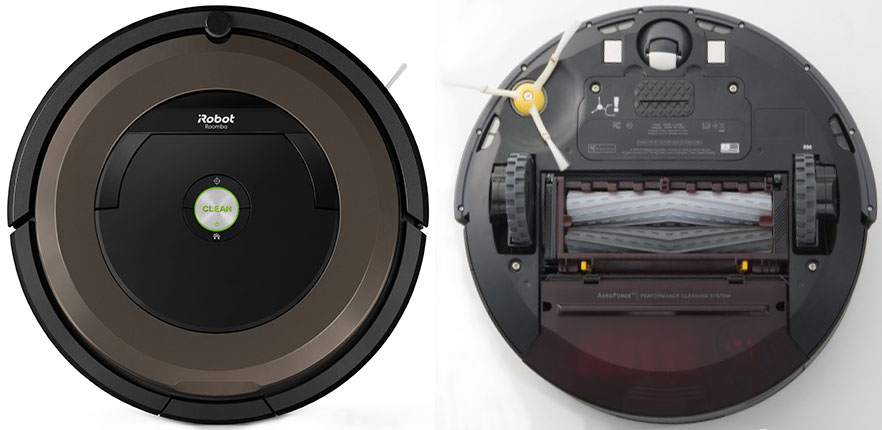
Roomba 890, compared to 690, introduces the AeroForce vacuuming bin with increased suction, high-efficiency filter and full bin indicator, easily-detangled debris extractors, and dirt detect series 2.
Roomba 960
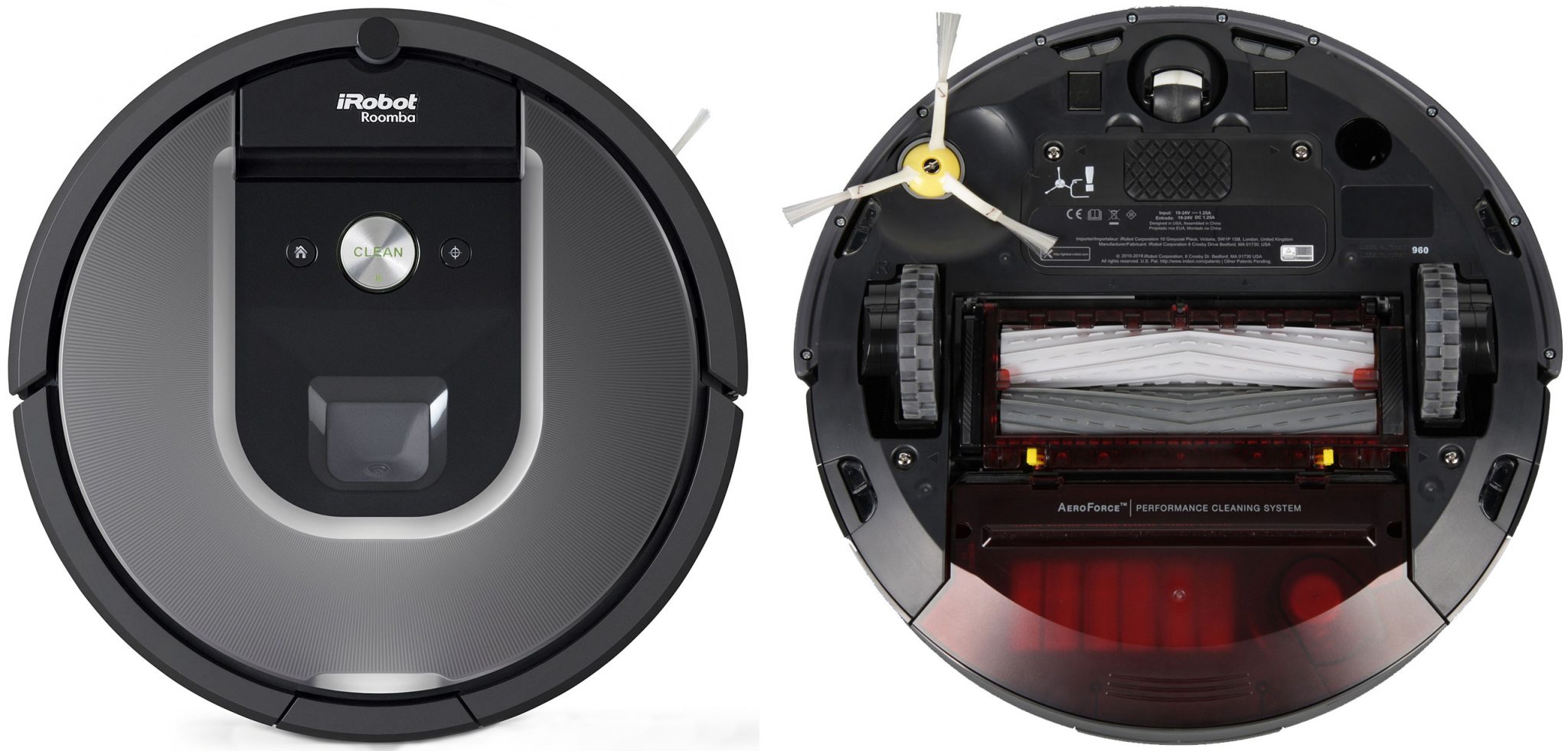
Roomba 960 resembles the 890’s cleaning system, but has iAdapt 2.0 mapped navigation, which allows multi-room cleaning, a bigger Li-ion 14.8V 2130mAh 31.5Wh battery, which provides 73 minutes runtime, two additional cliff sensors, and comes with an extra side brush in the package.
Roomba 980
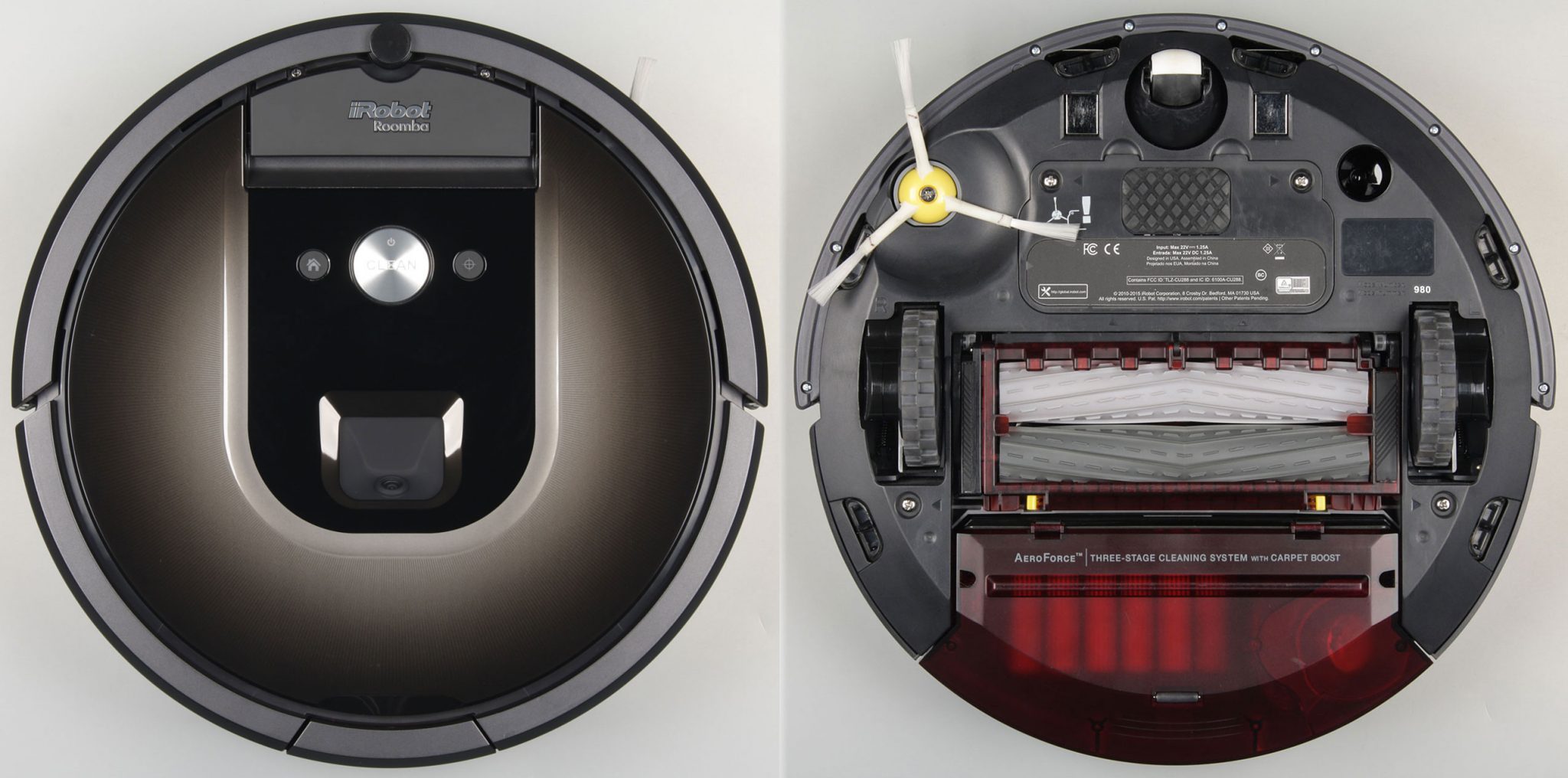
Roomba 980, compared to 960, has improved AeroForce with a gen 3 motor vacuuming bin that provides much more suction on carpets or on all the floor surfaces, and a bigger Li-ion 14.4V 3300mAh 47.5Wh batteries which allows it to run for 110 minutes runtime in “normal” power mode. It also has two virtual walls in the package.
Which Roomba is the best for pet hair?
The short answer, if we take the price off the table, is Roomba 980. It provides the best cleaning of pet hair and other dirt on all surfaces with the most powerful suction and the most advanced mapped navigation, has the biggest battery, and the most additional inclusions in the package. However, all of these features cost a lot of money.
In order to save some dollars, you can consider buying Roomba 960. It has the same navigation, but a less powerful motor without boost mode, smaller battery and one virtual wall in the package instead of two with 980. The most significant downgrade compared to 980 is suction power. It makes a great difference only on high-pile carpets, so if you have only hard floors and low carpets in your apartment, you may not need more suction and 960 will provide you nearly the same results as 980.
The next cheaper option is Roomba 890. It has the same cleaning system as 960, but simpler random navigation. It’s crucial if you want to clean a multi-room apartment, but if you have an open-plan apartment or you don’t mind cleaning one room at a time by blocking the robot’s exit from the room, you can totally opt for 890. It will clean nearly like 960 under these conditions, especially if you run it regularly.
If you don’t want to pay for 890 you can have a look at Roomba 690. It will navigate in the same way as 890, but provide slightly lower quality of cleaning, since with lower suction on the floor, it relies solely on dual roller brushes. In addition, it requires slightly more time for cleaning tangled hair from the roller brush with bristles. Otherwise, if scheduled for daily cleaning it will help in keeping your house clean.
Finally, if you don’t mind starting the robot manually by pressing the clean button, you can opt for Roomba 614. It will provide the same cleaning results as 690, but it can’t be controlled via the smartphone app and doesn’t have any virtual walls in the package. After all, you still have to empty the dustbin after every cleaning cycle in any model you choose. So, you can definitely empty the dustbin before the next cleaning cycle rather than after the current cleaning cycle and start the robot by pressing the clean button right after doing so.
If you have a house with multiple stories, you might get tired of moving the robot between two floors for cleaning and charging. In such a case, you can consider buying two of them, one for each floor. You can opt for the cheaper models with random navigation, especially if you have an open floor plan on both levels. Unfortunately, even the most expensive robotic vacuum cleaners cannot climb stairs yet.